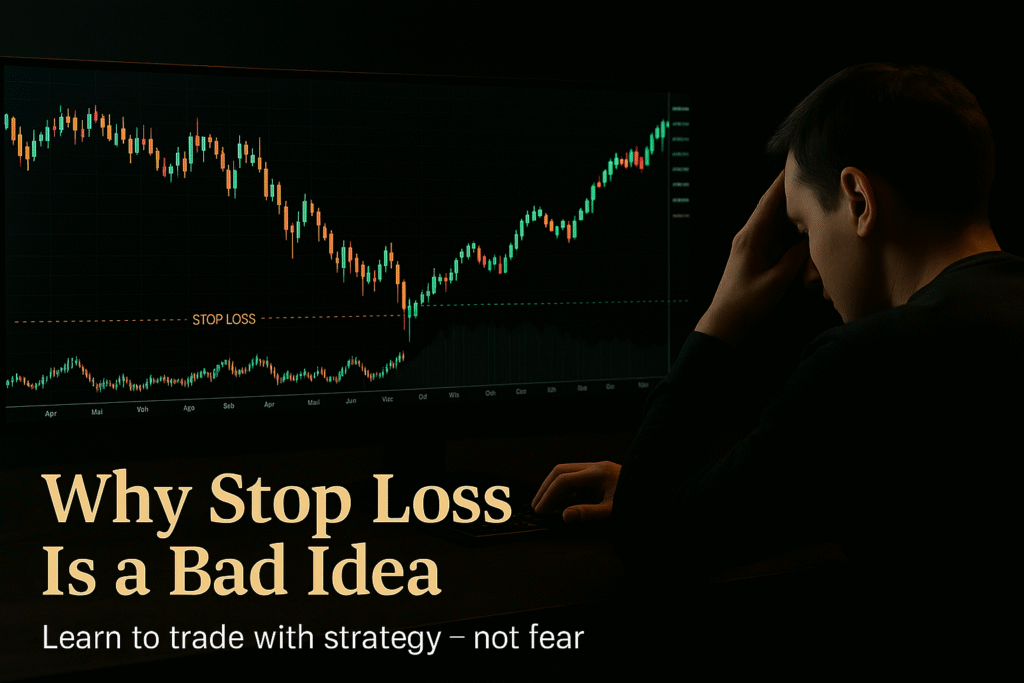When people talk about trading or investing in stocks, they often say, “Always use a stop loss.” A stop loss is a rule that says: “If the price falls to a certain point, sell it to stop losing more money.”
It sounds like a smart idea. After all, nobody wants to lose too much money, right?
But here’s the truth: a stop loss is not always helpful. In many cases, it can actually hurt your trading, make you feel frustrated, and stop you from making good profits. In this article, we’ll explain why some traders believe using a stop loss is a bad idea.
What Is a Stop Loss?
Before we talk about why it can be bad, let’s first understand what a stop loss is.
A stop loss is a type of trading order used to sell a stock automatically when it reaches a certain price. It’s meant to limit losses and prevent emotional decision-making.
Imagine you buy a toy that you think will become very popular. You pay 100 rupees for it. But just in case people don’t like it and the price drops, you decide, “If the price goes below 90 rupees, You will sell it and take a small loss.”
So you set a stop loss at 90. If the toy’s price ever hits 90, it will be sold right away. You only lose 10 rupees. That sounds safe, right?
But what if the price goes to 89 for just a minute… then jumps up to 120 the next day?
You lost the toy too early — and missed your chance to make a profit.
This is the problem many traders face. Let’s explore more.
1. It Sells Too Early When Price Moves Normally
The market always moves up and down. That’s normal. Prices do not go in a straight line. They bounce like a ball.
Now imagine this:
- You buy a stock at 100.
- You set a stop loss at 95.
- The price falls to 94. It hits your stop loss.
- Your stock is sold.
- Later, the price goes up to 120.
You lost the stock just because of a small dip. That’s what stop loss does. It makes you sell too early — even if the price was going to go back up.
This happens a lot. And it’s really frustrating.
2. Stop Loss Doesn’t Know the Future
A stop loss is like a robot. It doesn’t understand news, plans, or emotions. It just follows the number you set.
Let’s say a company has strong business, good profits, and many people believe in it. You buy its stock.
But one day, a fake news story says something bad about the company. People get scared, and the price drops quickly. Your stop loss gets hit, and you sell at a loss.
The next day, the news turns out to be false. The stock jumps back up.
You were right about the company. But your stop loss didn’t know that. It sold your stock anyway.
So you lost because of fear — not fact.
📚 To read more: Market manipulation – Wikipedia
3. Big Drops Can Make Stop Loss Useless
Sometimes, stock prices don’t fall slowly. They fall suddenly — like a rock.
Let’s say you buy a stock at 100. You set a stop loss at 90.
That night, bad news comes out. When the market opens, the first price is not 90. It’s 80. Your stop loss is hit, but you get only 80.
So instead of losing 10 rupees, you lost 20.
This is called a gap down. Stop loss does not work well in gap downs.
That means even if you set a stop loss, you might lose more than expected.
4. You Can Miss Big Profits
Let’s imagine you plant a seed in your garden. But after two days, you don’t see a flower, so you dig it out and throw it away.
You didn’t give it time to grow.
Trading is little like that.
- You buy a stock.
- You believe it will go up over time.
- But it falls a little first.
- Your stop loss is hit. You sell.
- Then, the price goes up just like you thought.
Your idea was right. But the stop loss didn’t let you wait.
You lost your chance to make money — just because of a small dip.
Sometimes, being patient is more important than being quick.
5. You Lose Money Again and Again
Let’s say you use a stop loss on every trade.
And let’s say the market keeps bouncing up and down like a rollercoaster.
Every time it dips a little, your stop loss sells your stock.
You take small losses again and again.
You never get to stay in a trade long enough to make profits.
Over time, all those little losses add up. And your account gets smaller and smaller.
Instead of saving you, your stop loss is slowly destroying your account.
6. It Can Make You Feel Nervous and Scared
Trading is not just about money. It’s also about how you feel.
When stop losses hit again and again, you might start to feel:
- Sad
- Angry
- Confused
- Scared to make another trade
You may stop believing in your own ideas. You may start overthinking everything. That fear can lead to even worse decisions.
A trader who is nervous will often sell too early or avoid good trades.
Stop loss can create fear, especially when it doesn’t work the way you hoped.
7. Market Makers Can See Your Stop Loss
Here’s a little secret.
Some big players in the market — like hedge funds and institutions — can see where most people put their stop losses.
So what do they do?
They push the price just enough to trigger those stop losses. This causes many small traders to sell.
Then, the big players buy those shares at low prices and push the stock back up.
You sold at a loss — and they made a profit.
It’s not fair. But it happens.
8. It’s Better to Watch Your Trades Yourself
Some traders believe it’s better to keep an eye on the trade — instead of using automatic stop losses.
That way, they can make smart choices based on:
- News
- Trends
- Market mood
- Personal plans
They don’t let a computer decide for them. They use their brain.
Yes, it takes more time and attention. But it also gives more control.
9. Not Every Trade Needs a Stop Loss
Some trades are not meant for quick profits. They are for the long term.
Let’s say you invest in a good company for 5 years. The price may go down a little in the first year — that’s okay.
If you use a stop loss, you might sell before the real growth begins.
Long-term investors often don’t use stop losses. They believe in their choice and give it time.
That’s another reason why stop loss is not always needed.This is why many value investors and buy-and-hold investors avoid stop losses altogether.
📚 To read more: Buy and Hold Strategy – Wikipedia
10. You Can Use Better Tools
Instead of stop loss, traders can use other tools to manage risk, like:
- Position sizing: Don’t put all your money into one trade.
- Trailing stop: A stop that moves up when price moves up.
- Mental stop: A price in your mind — not a computer order.
- Support levels: Use charts to find better places to exit.
These tools give you more control and flexibility.
Final Thoughts: Is Stop Loss Always Bad?
No, stop loss is not always bad.
For beginners or people who can’t watch the market all day, it can help.
But it’s not perfect. And using it the wrong way can cause more harm than good.
You should learn, practice, and understand the market before deciding when to use stop loss.
Every trader is different. What works for one person may not work for another.
But one thing is clear:
You should never blindly trust any tool — not even stop loss.
Always think, plan, and learn.
Conclusion: Think Before You Stop
Stop loss is like a safety belt. But even safety belts can sometimes be uncomfortable or not work the way you want.
Before you decide to use it, ask yourself:
- Am I using it just because others say it’s safe?
- Do I understand how the market moves?
- Am I giving my trades enough time to grow?
- Am I using stop loss out of fear?
If you use stop loss, use it wisely. Don’t let it control your trades. Let you be in charge.
Trading is not about avoiding all losses. It’s about managing them smartly and letting your good trades shine.
Sometimes, the best stop loss is not a tool — it’s your own patience, learning, and decision-making.

